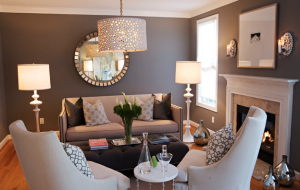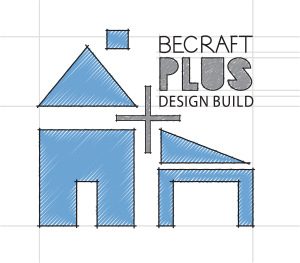
Make a 90 Degree Turn
Create boundary in a long, narrow living room by placing furniture at a 90 degree angle and perpendicular to the length of a room. This placement will give the room definition and help to prevent it from feeling tunnel-like. Smaller scale pieces like a love seat or a medium-sized Barcelona chair can do the trick.
Create a Focal Point
You’re heard it before – when it comes to small spaces, creating a focal point is the answer. Give your small room that focal point by creating an accent wall. You can use an artistic wall paper, a favorite paint color or a creative art work layout. You can also use framed photographs or paintings to create an eye catching wall. Another option is to use artistic shelving and storage units which can give you valuable storage space along with that artistic flair.
Plan Your Pathway
Make pathways a priority when planning the layout of your space. This is especially important for homes with an open floor plan. The easiest way is to create a straight pathway on one side of the room. In a narrow living room, you actually have two options. You can either place the walkway in front of the sofa or behind it. Walkways can clearly define where you should walk and can create either a more intimate seating area or a larger open area in the living room. By locating the pathway in front of the sofa it opens up the space to make it feel bigger. Keep in mind, having circulation throughout the space can be disruptive if traffic falls in front of a television. To determine the right solution, think about how much traffic comes through the room and how you intend to use the room.
Whichever layout you choose, make sure your pathway is clear and unobstructed. Avoid common pitfalls, such as a rug that lays halfway across the path which can pose a tripping hazard.
Create a Cozy Corner
This layout is as simple as it sounds – turn your focus to the corner of the room to create an inviting space. Placing your seating towards the corner and closer together creates a cozy and intimate seating arrangement. Turn side chairs at a slight angle facing towards the sofa. This creates a curved pathway through the room that is inviting and does not interfere with the function of the room. Extend any area rugs so that you can walk across it easily. Try placing a decorative screen, end table with a lamp or a large plant in the corner to “soften” it and fill-in the space.
Try a New Angle
Sometimes decorating means looking at things from a different angle. Believe it or not, placing a piece of furniture at an angle can make a small living room appear wider. Introducing an angle can be the perfect way to break up a space and to add interest. You can do this with the placement with your area rugs as well. Lighter looking furniture will keep the room feeling more open and spacious.
Coffee Talk
Though sometimes considered standard or conventional, the coffee table may be just the thing you need to add some dimension and style to your living room space. Get creative when contemplating a coffee table. Add some additional storage space by having a shelf underneath. Explore using unconventional pieces, such as an old trunk that can offer extra storage space or an ottoman (or two) with hidden storage. Square, rectangular or round….options are wide open depending on the look and feel you’re after.
Curves Ahead
A common mistake when laying out a small rectangular spaces is to line it with rectangular furniture. Too many rectangular shapes can ruin your living room layout. In contrast, curves are sexy and pleasing to the eye. They are also an excellent way to add interest and flow to a small room. Look for circular coffee tables and dining tables to add some curved lines to the room. Round lighting fixtures and/or round or oval rugs are other curvy options. Artwork doesn’t have to be all square either – round mirrors or framing can do the trick nicely.
Create a Floor Plan
Before starting your floor plan, take a step back and view the overall size and shape of the space. When laying out a small room, it’s a good idea to always determine the location of the largest piece of furniture first. For example, a longer sofa fits best along the longest wall. Taking into consideration the size, shape and desired configuration is your best bet in creating a floor plan that works for you. A floor plan will help you to see your room layout and what will fit before you start moving furniture around or shopping for new pieces. This will save you time, money
and effort. Just because your space is small doesn’t mean it can’t deliver big on design and function.
For help with design and renovations, contact a qualified design specialist to help you create the space you desire.
Creativity makes all the difference in remodeling your home! Becraft Plus has experience with every type of siding on the market. Contractor experience makes all the difference.
Contact Us (301-929-3401) For a Free Consultation!
—
 About Becraft Plus
About Becraft Plus
Since 1989, Becraft Plus has provided customized design and construction services to customers in the Washington, D.C. area. We specialize in custom home building, additions and remodeling, and whole house renovations with a focus on creating living spaces that are tailored to the needs of our clients.
>> Learn More

 About Becraft Plus
About Becraft Plus

